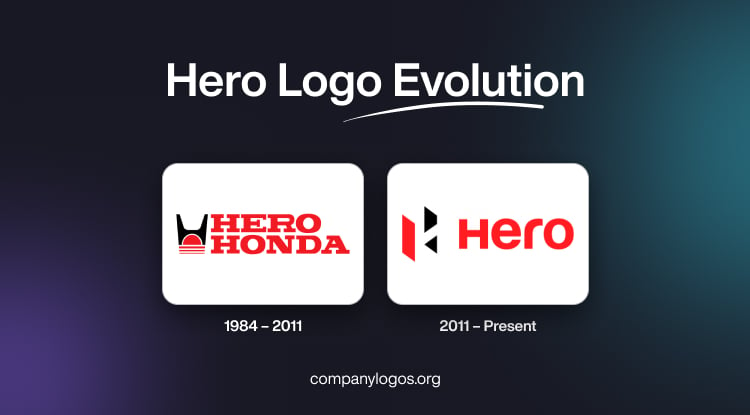
Hero, or Hero MotoCorp Limited, is an Indian brand known for being the largest motorcycle manufacturer in the world. Founded by entrepreneur Brijmohan Lal Munjal, it also produces two-wheelers, such as scooters and electric bicycles. The Hero logo is one of the most recognisable symbols in India’s automotive industry.
It embodies strength, progress, and a spirit of reliability. Over the decades, the logo has evolved with a single change. It reflects the brand’s growth from a local manufacturer into a global two-wheeler giant. This article explores the journey of the Hero logo, among other details of the company.
The Genesis of the Hero Honda Logo (1984 – 2011)
The first Hero logo appeared in 1984, the year that marked the launch of the Hero Honda partnership between India’s Hero Cycles and Japan’s Honda Motor Company. The logo featured the wordmark “Hero Honda” in two levels and rendered in bold, uppercase serif letters.
To the left of the wordmark was a stylised “H” in black on top of a red semicircle. It represented the rising sun (an homage to Honda’s Japanese origins), with three horizontal lines in red beneath it. These symbolised the tracks of two-wheelers and reflected dynamism and progress. The colours of the logo evoked passion, energy, and strength.

(2011 – Present)
In 2011, the Japanese company Honda decided to leave the brand, which necessitated a change in the corporate identity of the company. To design the new logo, the London-based Wolff Olins, which is renowned for its strategic brand designs, was taken on board. The new logo debuted in London on August 9, 2011, during a high-profile cricket match between India and England.
It featured an emblem and the brand name. The emblem depicted a modern, geometric, stylised, yet fragmented letter “H” rendered in red, black, and white. The “H” appears three-dimensional and is formed by a red parallelogram on the left, a black trapezoid and triangle on the right, and a floating connecting bar offering a sense of continuity.
To the right of the emblem appears the wordmark “Hero” written in a clear, sans-serif font in lowercase letters with a capital “H.” The colour red conveys confidence, passion, and continuity, while black reflects power and stability. White as a background reflects modernity and clarity.
In terms of symbolism, the angular, fragmented “H” is designed to convey energy, progress, and independence. The sharp corners and geometric precision of the logo reflect robust engineering and a forward-looking approach. Further, the tagline “Hum Mein Hai Hero” (“There is a Hero in Us”) reinforced the company’s positioning as a brand for the everyday hero.

The Elements of the Hero Logo
Font
The wordmark used in the Hero logo features letters in the title case and is rendered in a sans-serif typeface. The font used to write the wordmark is similar to Harabara. The rounded letter “r” makes the whole wordmark appear sleek and modern.
Colour
The colour palette of the Hero logo is red, white, and black. Here, black conveys strength, while red depicts beauty.
The History of Hero
The roots of Hero can be traced back to 1944, during the tumultuous period of India’s Partition. The Munjal family, originally from erstwhile Pakistan, migrated to Ludhiana, Punjab, and began their journey with a small trading business. Led by the visionary Brijmohan Lall Munjal, the family soon began manufacturing bicycle components.
In 1956, this vision materialised into the establishment of Hero Cycles Limited. Over the following decades, Hero Cycles revolutionised India’s bicycle industry. By 1975, it had become the country’s single largest bicycle manufacturer, and in 1986, it achieved international recognition by entering the Guinness Book of Records as the world’s largest bicycle maker.
During the 1960s and 1970s, the Hero Group diversified its operations through the launch of component-production subsidiaries. These included Rockman Cycles, established in 1961 to manufacture bicycle chains and hubs, and Majestic Auto Limited, launched in 1978 to produce mopeds. During the early 1960s, Hero also began exporting bicycles and gradually began extending its footprint beyond the Indian subcontinent. This period was marked by rapid industrial growth and diversification and laid the groundwork for entry into the motorised vehicle market.
In 1984, Hero entered into a historic joint venture with Japan’s Honda Motor Company, which led to the formation of Hero Honda Motors Ltd. This venture marked a major milestone and brought four-stroke fuel-efficient motorcycle technology to India. The following year, in 1985, Hero Honda launched its first motorcycle, the CD 100, which rolled off the assembly line at the Dharuhera plant in Haryana. Over the next two decades, the company launched a string of successful models, including the iconic Splendour and Passion. These reinforced the reputation of Hero Honda for reliability, fuel efficiency, and affordability.
Hero Honda’s popularity grew rapidly during the 1990s and 2000s, with its innovative marketing campaigns, such as the memorable “Fill It—Shut It—Forget It” tagline. By 2001, the company was producing record volumes and had emerged as the world’s largest two-wheeler manufacturer by volume, a title it continues to hold. Models like the Splendour became the top-selling motorcycles in the world. These catapulted Hero Honda to unmatched levels of market dominance in India’s two-wheeler segment.
In 2010, the Hero-Honda joint venture formally came to an end, with the Hero Group buying out Honda’s 26% stake and assuming full control. The momentous separation led to a new chapter in the company’s history. In 2011, Hero Honda was replaced by Hero MotoCorp Limited to reflect its focus on independent growth and global ambitions. The rebranded Hero MotoCorp introduced a new logo and brand identity, which was unveiled by international branding firm Wolff Olins. This marked a subtle but significant shift, that is, from a trusted domestic name to a confident global entity poised for global mobility leadership.
After the rebranding, Hero MotoCorp accelerated its global expansion plans. It entered markets in Latin America, Africa, the Middle East, and parts of Southeast Asia. To enhance its innovation capability, the company set up a world-class R&D centre, the Centre of Innovation and Technology (CIT) in Jaipur, India, and acquired Germany-based Automobile Engineering Firm (formerly part of Erik Buell Racing) to strengthen high-performance product development. Hero MotoCorp also began exports and launched operations in international manufacturing, including a plant in Bangladesh.
The company made strategic investments in electric mobility. It partnered with Indian electric scooter startup Ather Energy. At the same time, Hero expanded its lineup of scooters and motorcycles to cater to evolving customer preferences. The two-wheelers adopted smart features such as Bluetooth connectivity and mobile app integration in their new models.
Founded by the legendary Brijmohan Lall Munjal, Hero continues to be led by his family. For instance, Dr. Pawan Munjal serves as executive chairman and Niranjan Gupta as chief executive officer. Under their leadership, the company has pursued both technological progress and social responsibility. Hero MotoCorp has launched multiple initiatives in education, health, community development, and road safety. Institutions like the Raman Munjal Vidya Mandir and various rural healthcare programs have been established to support underprivileged communities and help raise social standards.
The journey of Hero has been marked by several key milestones. In 1956, Hero Cycles was founded. Rockman Cycles followed in 1961 and Majestic Auto Limited in 1978. By 1975, Hero Cycles had become the largest bicycle manufacturer in India, and in 1984, the Hero Honda joint venture was established. The first motorcycle under Hero Honda, the CD 100, launched in 1985, and by 1991, production had crossed 500,000 units.
Hero became the world’s largest two-wheeler manufacturer in 2001 and rebranded itself post the Honda split in 2011. From 2014 onwards, Hero MotoCorp made consistent global advancements, built R&D capabilities, and laid significant groundwork in alternative mobility.
Hero has evolved from a partition-era trading business to a global-scale mobility powerhouse. It is inarguably one of India’s most inspiring industrial success stories. Through innovation, strategic vision, and unwavering dedication to quality and affordability, the company has transformed the everyday mobility of millions. It has become a symbol of reliability, progress, and the entrepreneurial spirit of modern India.
Interesting Facts About Hero
- Hero MotoCorp is part of the Hero Group and was founded by Brijmohan Lall Munjal. It began with bicycle manufacturing and grew into a massive business empire.
- Hero MotoCorp has consistently held the title of world’s largest two-wheeler manufacturer in terms of unit volume sold in a calendar year. This record has been maintained for more than a decade.
- Hero began as Hero Honda in 1984, which was a joint venture between Hero Cycles of India and Honda of Japan. This partnership was the key to transforming India’s motorcycle landscape.
- In 2010, Hero and Honda parted ways. Post the split, Hero rebranded itself as Hero MotoCorp and went on to develop its own R&D capabilities.
- Hero exports to over 40 countries across Asia, Africa, South and Central America, and the Middle East. It has also set up manufacturing units in Colombia and Bangladesh.
- Hero established its world-class R&D facility, the CIT, in Jaipur, Rajasthan. This serves as the nerve centre for product innovation and development.
- Hero MotoCorp emphasises green mobility. It has launched electric products under its VIDA brand and is investing in future mobility solutions like hydrogen-powered vehicles and battery-swapping technologies.
- Some of the iconic models of Hero include:
- Hero Splendour (one of the highest-selling motorcycles in history)
- HF Deluxe
- Passion Pro
- Karizma, a cult favourite in the performance segment.
- Hero actively participates in global motorsports, especially the Dakar Rally.
Finally
The history and evolution of the Hero logo shows the trajectory of the company itself. It includes steady beginnings, a transformative split, and an energetic push into the future. What began as a symbol of partnership and reliability has become an emblem of confidence, movement, and independence. These qualities continue to drive the Hero brand forward.